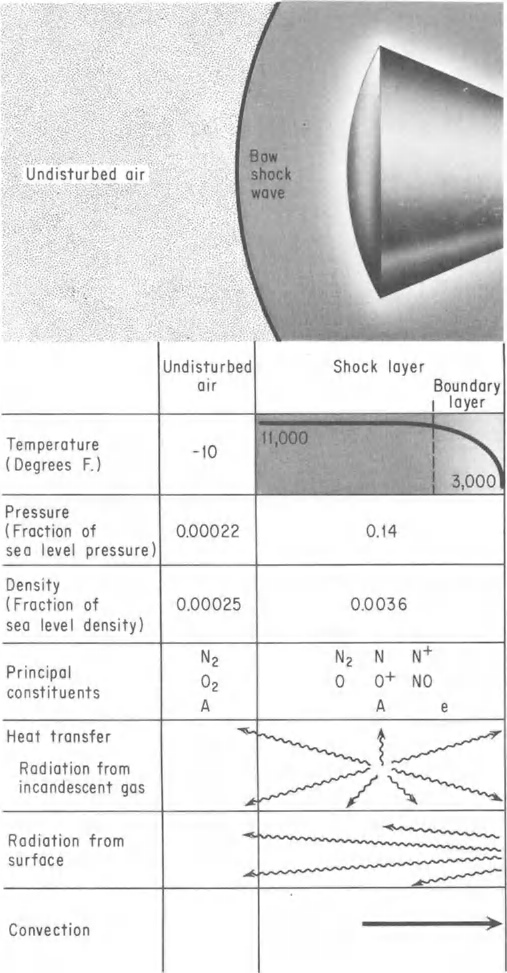Physical Understanding of Re-entry phenomena

The concept of atmospheric re-entry is beautifully explained in very simple terms by W.T.Loh [1] and John Becker [2], and the same idea is reproduced in the following sentences. An object or a vehicle approaching the Earth or a planetary atmosphere from space possess a large amount of potential and kinetic energy at the point of entry. When it encounters the atmosphere, a shock wave will form ahead of the vehicle, heating the atmosphere around this region to a very high temperature. As the vehicle encounters more denser atmosphere, the vehicle will increasingly be heated by this enveloping layer of incandescent atmosphere, while the speed of the vehicle continuously be reduced by the force of the atmosphere. It is in this manner a vehicle’s energy is converted into heat. If all the vehicle’s kinetic energy is converted to heat energy within the vehicle itself, it would be more than enough to vaporize the vehicle, its payload and any cooling system it could carry. However, the natural survival of meteorites is the physical evidence that not all of the energy appears within the body itself. Actually, a large part of the total energy is diverted away from the vehicle. This can be done in two ways, unload a major part of heat away from the vehicle by using strong shock waves and radiate heat away from the hot surfaces of the vehicle.
When molecules strike the projected surface, they bounce back. Many of the rebounding molecules collide with the oncoming molecules, deflecting them from the surface and preventing them from heating the projected surface by direct impact. The high pressure, high temperature buffer layer in which this phenomena happens is bounded on its forward surface by the shock wave. The wave extends considerable distance into the atmosphere on either side of the body, leaving a broad wake of heated gas that contains a major portion of the total heat load. The heat that does reach the vehicle comes from the shock layer mainly by friction. The fraction of the total energy that appears as frictional heat in the body depends upon the characteristics of the flow around the body. A blunt nose produces the strongest shock waves. Since the fraction of the total heat load that is transferred to the atmosphere is directly proportional to the strength of the shock wave, the stronger the shock wave, the smaller the frictional component introduced into the body. For this reason an entry vehicle is designed to have a blunt shape rather than the slender, streamlined configuration that has been the classic solution to aerodynamic problems at lower speeds. However, at the conditions during re-entry, convection and radiation from the shock layer will constitute a substantial portion of the heat transferred to the body (See Fig.1).
Following the design ideas to disperse the heat that reaches the vehicle (for survivability reasons), we have different solutions which are mainly based on the type of the re-entry conditions (mostly velocity) and the type of the trajectory. For example, in the case of ballistic or steep-angle entry into atmosphere, the vehicle reaches the lower and denser atmosphere in a very short time. In such a case a blunt-nosed, thick-skin, heat-sink-type heat shield may be used. However, for a lunar entry trajectory this simple approach will not be enough and the solution would be to use a heat shield constructed of insulating layers of fiberglass and similar materials, properly applied and bonded. Under intense heat, the outer layer of the shield chars, melts and vaporizes. This process, known as ablation [3], absorbs an immense amount of heat and in-addition the vaporized material blocks the flow of heat from the hot shock layer into the body. Such design approaches were very effective for the design of space missions and are responsible for our invaluable achievements in the past century.
References
[1] Loh, Wellington HT. Re-entry and planetary entry physics and technology: Dynamics, physics, radiation, heat transfer and ablation. Vol. 1. Springer, 1968.
[2] Becker, John V. “Re-entry from space.” Scientific American 204.1 (1961): 49-57.
[3] Curry, Donald M. An analysis of a charring ablation thermal protection system. No. NASA-TN-D-3150. National Aeronautics and Space Administration Houston TX Manned Spacecraft Center, 1965.